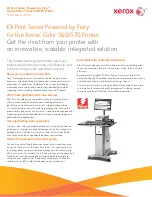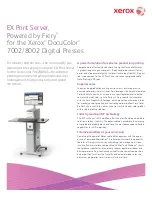
• Registered ECC DDR3 memory
• Microprocessor built-in self-test (BIST) during power-on self-test (POST)
• Microprocessor serial number access
• PCI PMI 2.2
• PCI Express 1.0a
• POST
• ROM-resident diagnostics
• Service processor that communicates with the advanced management module to enable remote blade
server management
• System-error logging
• Wake on LAN capability
• Wake on PCI (PME) capability
• Wake on USB 2.0 capability
IBM Systems Director
IBM Systems Director is a platform-management foundation that streamlines the way you manage physical
and virtual systems in a heterogeneous environment.
By using industry standards, IBM Systems Director supports multiple operating systems and virtualization
technologies in IBM and non-IBM x86 platforms.
Through a single user interface, IBM Systems Director provides consistent views for viewing managed
systems, determining how these systems relate to one another, and identifying their statuses, helping to
correlate technical resources with business needs. A set of common tasks that are included with IBM
Systems Director provides many of the core capabilities that are required for basic management, which
means instance business value. These common tasks include discovery, inventory, configuration, system
health, monitoring, updates, event notification, and automation for managed systems.
The IBM Systems Director web and command-line interfaces provide a consistent interface that is focused
on driving these common tasks and capabilities:
• Discovering, navigating, and visualizing systems on the network with the detailed inventory and
relationships to the other network resources
• Notifying users of problems that occur on systems and the ability to isolate sources of the problems
• Notifying users when systems need updates and distributing and installing updates on a schedule
• Analyzing real-time data for systems and setting critical thresholds that notify the administrator of
emerging problems
• Configuring settings of a single system and creating a configuration plan that can apply those settings to
multiple systems
• Updating installed plug-ins to add new features and functions to the base capabilities
• Managing the life cycles of virtual resources
For more information about IBM Systems Director, see the documentation at http://publib.boulder.ibm.com/
infocenter/director/v6r2x/index.jsp, and the IBMxSeries Systems Management website at http://www.ibm.
com/systems/management/, which presents an overview of IBM Systems Management and IBM Systems
Director.
Major components of the blade server
Use this information to locate the major components on the blade server. The major components of the
blade server include field replaceable units (FRUs), customer replaceable units (CRUs), and optional devices.
.
11
Summary of Contents for 1909
Page 1: ...BladeCenter HX5 Blade Server Installation and User s Guide Machine Types 7873 7872 1910 1909 ...
Page 80: ...72 BladeCenter HX5 Blade ServerInstallation and User s Guide ...
Page 112: ...104 BladeCenter HX5 Blade ServerInstallation and User s Guide ...
Page 116: ...108 BladeCenter HX5 Blade ServerInstallation and User s Guide ...
Page 120: ...112 BladeCenter HX5 Blade ServerInstallation and User s Guide ...
Page 126: ...118 BladeCenter HX5 Blade ServerInstallation and User s Guide ...
Page 133: ...Taiwan Class A compliance statement Appendix B Notices 125 ...
Page 134: ...126 BladeCenter HX5 Blade ServerInstallation and User s Guide ...
Page 139: ......
Page 140: ...Part Number 00V9872 Printed in China 1P P N 00V9872 ...
Page 141: ... 1P00V9872 ...
















































